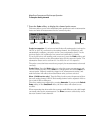
4-8
MegaZoom Concepts and Oscilloscope Operation
To setup the Analog channels
Vertical sensitivity Turn the large knob above the channel key to set the
sensitivity (volts/division) for the channel. The volts/division knob changes the
analog channel sensitivity from 1 mV to 5 V for the 54620-series and from 2 mV
to 5 V for the 54640-series in a 1-2-5 step sequence with a 1:1 probe attached.
The analog channel Volts/Div value is displayed in the status line.
Vertical expansion The default mode for expanding the signal when you turn
the volts/division knob is vertical expansion about the ground level. To set the
expansion mode to expand about the center of the screen instead, press Expand
in the Utility Options menu and select Center.
Ground level The ground level of the signal for each displayed analog channel
is identified by the position of the icon at the far-left side of the display.
Channel position Turn the small channel position knob ( ) to move the
channel waveform up or down on the display. The voltage value momentarily
displayed in the upper right portion of the display represents the voltage
difference between the center graticule and the ground level ( ) icon. It also
represents the voltage at the center graticule.
2Press the Coupling softkey to select the input channel coupling.
Coupling changes the channel’s input coupling to either AC (alternating
current), DC (direct current), or Ground (hardware ground on 54620-series
only). AC coupling places a 3.5 Hz high-pass filter in series with the input
waveform that removes any DC offset voltage from the waveform. When AC is
selected, “AC” is illuminated on the front panel next to the channel position
knob ( ).
• DC coupling is useful for viewing waveforms as low as 0 Hz that do not
have large DC offsets.
• AC coupling is useful for viewing waveforms with large DC offsets, or with
slowing moving DC offsets.
• Ground coupling (54620-series only) is useful for removing clutter on
screen, estimating the baseline noise contribution by the oscilloscope, and
measuring the difference between oscilloscope ground and
device-under-test ground.


















